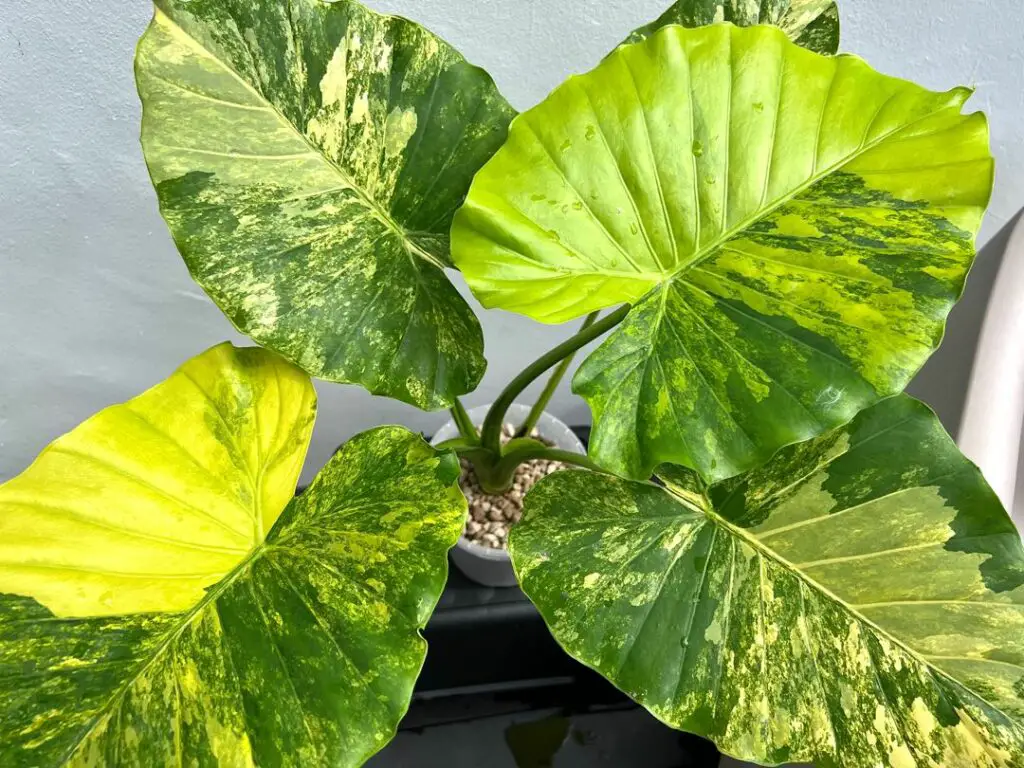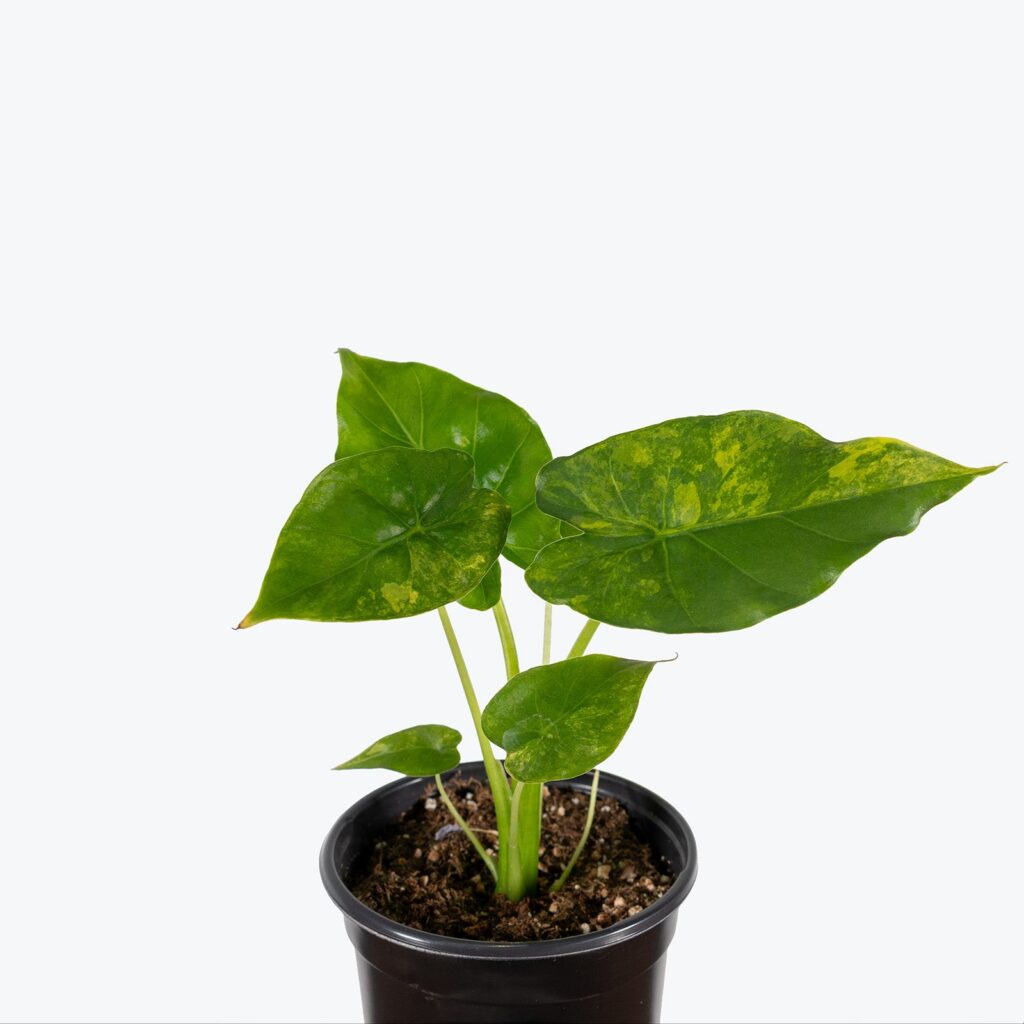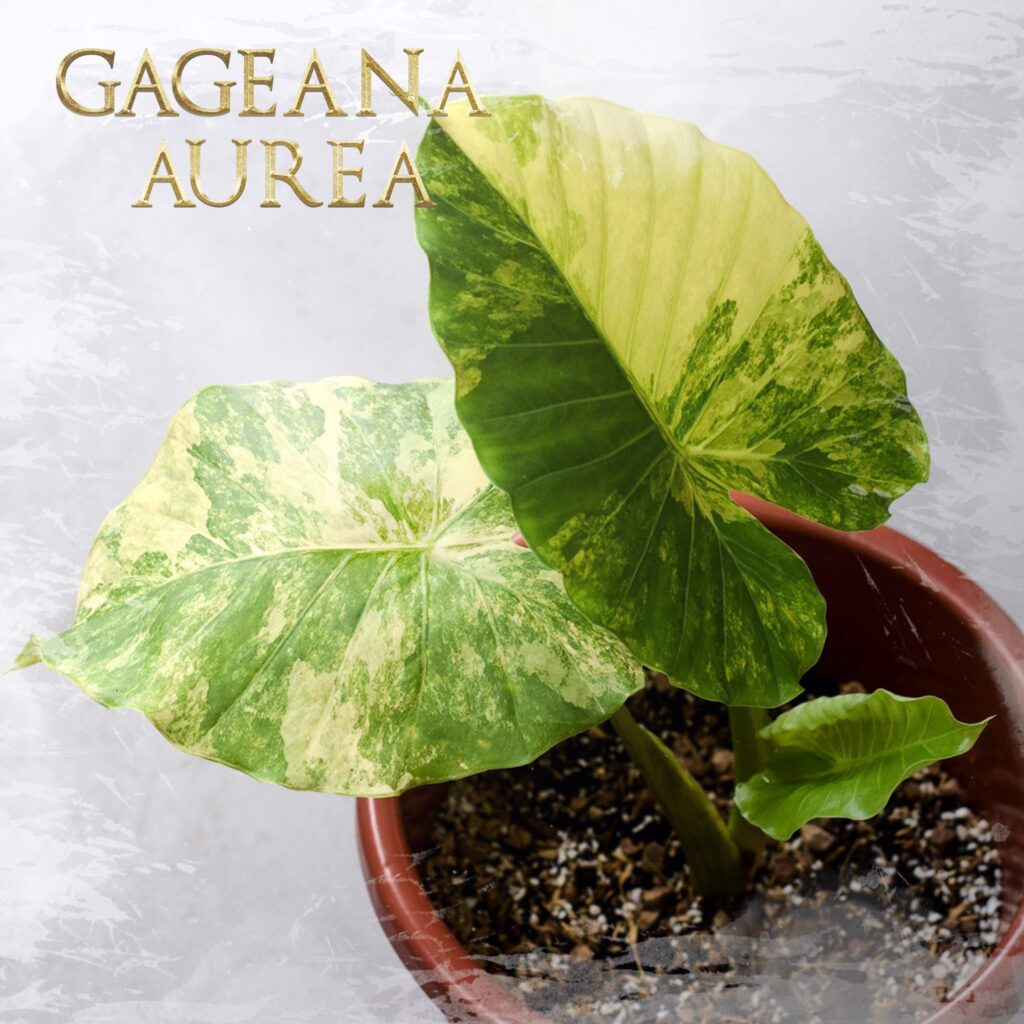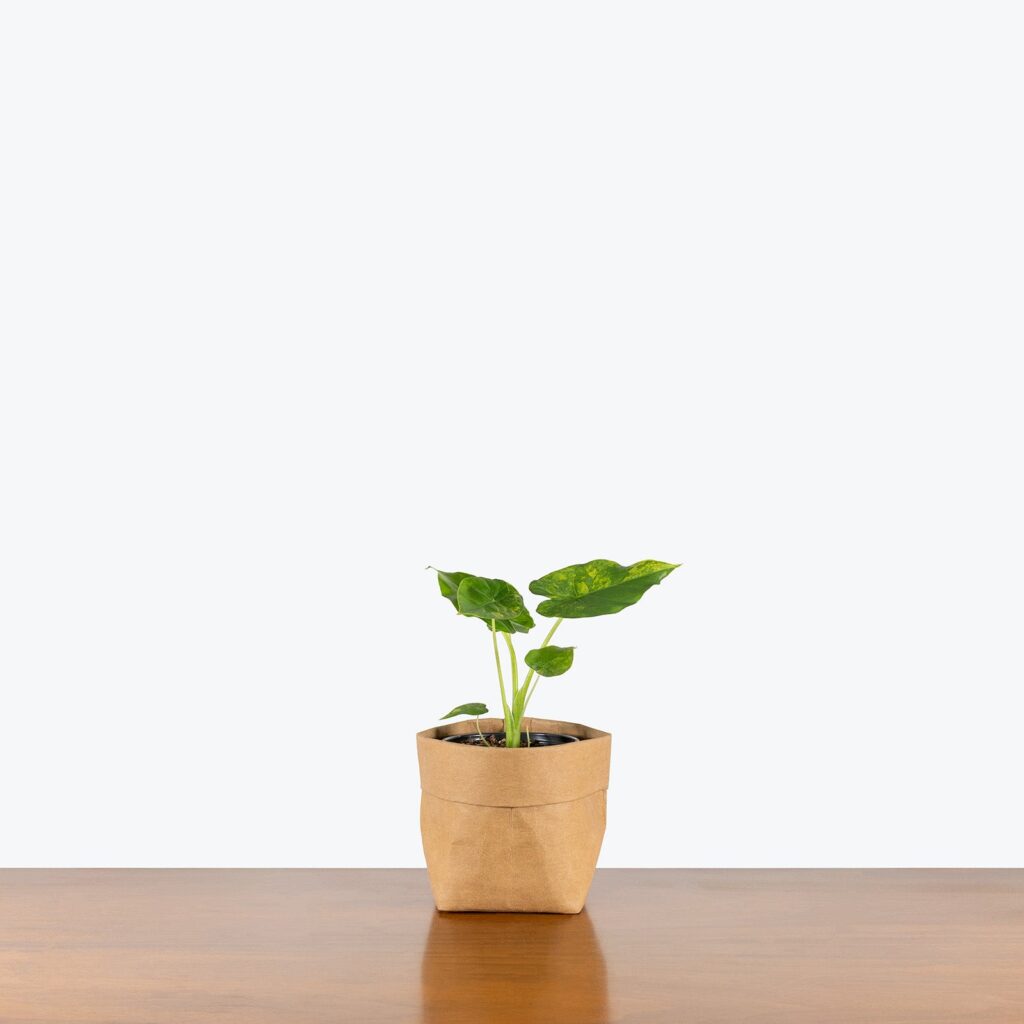Aurea Alocasia, also known as the Golden Dragon Plant, is admired for its striking foliage and unique leaf shape. This tropical plant thrives in warm, humid environments and requires specific care to maintain its vibrant color and health.
Introduction to Aurea Alocasia
The Aurea Alocasia is a stunning member of the Alocasia family, which is renowned for its dramatic foliage. Native to tropical regions, this plant can bring a touch of exotic beauty to any indoor space. Its leaves are characterized by a distinctive arrow shape, often adorned with a glossy green surface and striking golden veins that give it the name “Golden Dragon.” This unique appearance makes it a favorite among houseplant enthusiasts and collectors.

While the Aurea Alocasia is undeniably beautiful, it does require careful attention to thrive. Understanding its specific needs in terms of light, water, humidity, and soil type is essential for keeping it healthy and vibrant. Below are some key features that make the Aurea Alocasia stand out, along with tips on how to care for it effectively.
Unique Features of Aurea Alocasia
The Aurea Alocasia possesses several unique features that make it a captivating choice for plant lovers:
- Distinctive Leaf Shape: The arrow-shaped leaves create an eye-catching silhouette.
- Colorful Veining: The striking golden veins running through the dark green leaves enhance its visual appeal.
- Tropical Origin: Being native to tropical regions means it thrives in warm and humid conditions.
- Air-Purifying Qualities: Like many houseplants, Aurea Alocasia helps improve indoor air quality.
Care Requirements for Aurea Alocasia
Caring for an Aurea Alocasia involves providing the right environment and maintenance to ensure its growth. Here are some essential care tips:

Light Conditions
Aurea Alocasia thrives best in bright, indirect light. Direct sunlight can scorch the leaves, while too little light can hinder growth. A spot near a window with filtered light is ideal. If natural light is limited, consider using grow lights to supplement the plant’s needs.
Watering Needs
Watering is crucial for maintaining the health of your Aurea Alocasia. The soil should be kept consistently moist but not soggy. Overwatering can lead to root rot, while underwatering can cause the leaves to droop. It’s best to allow the top inch of soil to dry out before watering again.
Humidity Levels
This plant thrives in high humidity environments. A humidity level of 60% or higher is ideal. To increase humidity, you can mist the leaves regularly, use a pebble tray with water, or invest in a humidifier. Keeping the plant away from drafts and heating vents can also help maintain the necessary humidity levels.

Soil Type
Aurea Alocasia prefers a well-draining potting mix that retains some moisture. A blend made from peat moss, perlite, and orchid bark works well to provide aeration and drainage. Avoid heavy soils that can retain too much water.
Nutrient Requirements
Feeding your Aurea Alocasia during the growing season is essential for vibrant growth. Use a balanced liquid fertilizer diluted to half strength every four to six weeks from spring to fall. During winter, reduce feeding as the plant’s growth slows down.
| Care Aspect | Recommendation |
|---|---|
| Light | Bright, indirect light |
| Watering | Keep soil moist but not soggy |
| Humidity | At least 60% humidity |
| Soil | Well-draining potting mix |
| Fertilizer | Balanced liquid fertilizer every 4-6 weeks in the growing season |
With proper care, your Aurea Alocasia can flourish and become a stunning centerpiece in your home or office. Understanding its unique features and requirements is the first step toward ensuring its longevity and health.
Pests and Diseases of Aurea Alocasia
While the Aurea Alocasia is a beautiful and resilient plant, it can be susceptible to certain pests and diseases. Being aware of these potential issues can help you take preventive measures and respond promptly if they occur.

Common Pests
Several pests may target the Aurea Alocasia, including:
- Spider Mites: These tiny pests thrive in dry conditions. They can cause yellowing leaves and fine webbing on the undersides of leaves.
- Mealybugs: These insects appear as white, cotton-like masses on the leaves and stems. They can lead to wilting and stunted growth.
- Scale Insects: Scale insects attach themselves to the plant and sap nutrients, causing leaf yellowing and dropping.
- Aphids: These small, green insects feed on new growth, leading to curling leaves and stunted plant growth.
Preventive Measures
To prevent pest infestations, consider the following strategies:
- Regular Inspections: Check your plant frequently for any signs of pests or damage.
- Proper Care: Maintain optimal growing conditions, as healthy plants are less susceptible to pests.
- Isolation: If you introduce new plants, keep them isolated for a few weeks to monitor for pests before integrating them with existing plants.
Treating Pest Infestations
If you notice pests on your Aurea Alocasia, prompt action is essential. Here are some effective treatment options:
- Insecticidal Soap: This can help eliminate soft-bodied insects like aphids and mealybugs. Spray directly onto the affected areas.
- Neem Oil: A natural pesticide that can disrupt the life cycle of many pests. It also has the added benefit of acting as a fungicide.
- Horticultural Oil: This oil can suffocate pests when applied correctly, targeting scale insects and spider mites effectively.
Always follow the manufacturer’s instructions when using chemical treatments and ensure proper ventilation in the area where the plant is located.
Common Diseases
Aurea Alocasia can also be affected by several diseases. The most common include:
- Root Rot: Caused by overwatering or poorly draining soil, root rot can lead to wilting and yellowing leaves. Ensure that you allow the soil to dry out between watering sessions.
- Leaf Spot: This condition manifests as dark or light spots on the leaves, often due to fungal infections. Maintaining adequate air circulation and avoiding overhead watering can help prevent this disease.
- Pythium Blight: A serious disease that can cause rapid decay in roots and stems. It is often associated with overly wet conditions and poor drainage.
Disease Prevention Strategies
To minimize the risk of diseases affecting your Aurea Alocasia, consider implementing these strategies:
- Avoid Overwatering: Ensure that your pot has drainage holes and that excess water can escape.
- Maintain Cleanliness: Regularly remove dead or yellowing leaves from the plant to reduce the risk of disease spread.
- Proper Air Circulation: Ensure adequate spacing between plants to promote airflow, which helps reduce humidity levels around foliage.
Repotting Aurea Alocasia
Repotting is an important aspect of caring for your Aurea Alocasia. It allows you to refresh the soil, provide more space for growth, and check the health of the roots. Here’s what you should know about repotting:
When to Repot
You should consider repotting your Aurea Alocasia when:
- The roots are growing out of the drainage holes at the bottom of the pot.
- The plant has outgrown its current pot, making it difficult for soil to retain moisture.
- The soil has become compacted or depleted of nutrients after several months of growth.
How to Repot
When repotting your Aurea Alocasia, follow these steps:
- Select a pot that is one size larger than the current one with drainage holes.
- Prepare fresh potting mix suitable for Alocasia plants.
- Gently remove the plant from its current pot, taking care not to damage the roots.
- Inspect and trim any damaged or rotten roots before placing the plant in the new pot.
- Add fresh soil around the root ball, ensuring it is planted at the same depth as before.
- Water thoroughly to help settle the soil around the roots.
Repotting can stimulate growth and rejuvenate your Aurea Alocasia, making it a vital part of its care routine. Proper attention to pests, diseases, and repotting will contribute significantly to maintaining the health and beauty of this unique plant.
Propagation of Aurea Alocasia
Propagation is an exciting way to multiply your Aurea Alocasia and share it with friends or add to your own collection. There are several methods for propagating this plant, and understanding them can help you successfully grow new plants.
Methods of Propagation
The most common propagation methods for Aurea Alocasia include:
- Division: This method involves separating offsets or pups from the main plant.
- Leaf Cuttings: Although not as commonly successful as division, you can propagate new plants from leaf cuttings.
Propagation by Division
Dividing your Aurea Alocasia is the preferred method for propagating this plant. Here’s how to do it:
- Timing: The best time to divide is during the spring or early summer when the plant is actively growing.
- Prepare the New Pots: Select pots that are slightly larger than the root ball and fill them with a fresh, well-draining potting mix.
- Remove the Plant: Gently take the plant out of its pot, being careful not to damage the roots.
- Identify Offsets: Look for smaller plants or offsets attached to the main root system.
- Separation: Use a clean, sharp knife to carefully separate the offsets from the main plant, ensuring each piece has roots.
- Replant: Place each offset in its new pot and cover with soil. Water lightly to help settle the soil around the roots.
Propagation by Leaf Cuttings
While not always successful, you can attempt propagation through leaf cuttings if you prefer this method. Follow these steps:
- Select a Healthy Leaf: Choose a mature leaf that is healthy and disease-free.
- Cut the Leaf: Using a sharp knife or scissors, cut a section of the leaf that is at least 6 inches long. Make sure to include a portion of the stem.
- Treat the Cutting: Allow the cutting to dry for a few hours to form a callus on the cut end, which helps prevent rot.
- Plant the Cutting: Place the cutting in a pot with moist potting mix, burying the cut end about an inch deep.
- Provide Care: Keep the soil moist and place the pot in a warm, humid location to encourage root development.
Caring for Young Plants
Once you propagate your Aurea Alocasia, caring for young plants is essential to ensure their growth and vitality. Here are some tips for nurturing them:
Light Requirements
Younger plants typically require bright, indirect light similar to mature plants. Avoid placing them in direct sunlight, as they are more sensitive and can easily scorch. A spot near a window with filtered light is ideal for their development.
Watering Young Plants
Young Aurea Alocasia should be watered carefully. Here are some guidelines:
- Moisture Monitoring: Keep an eye on the soil moisture levels. It should remain consistently moist but never soggy.
- Avoid Overwatering: Allow the top inch of soil to dry before watering again to prevent root rot.
Humidity Levels
Young plants thrive in high humidity. You may consider using a humidity dome or placing a tray of water near them to elevate humidity levels. Regular misting can also be beneficial.
Nutrient Needs
Young Aurea Alocasia require nutrients for healthy growth. Here’s how to provide them:
- Fertilizing Schedule: Use a diluted balanced fertilizer every 4-6 weeks during their active growing season (spring and summer).
- Soil Quality: Ensure that the potting mix contains organic matter to support nutrient retention.
Seasonal Care Adjustments
Caring for your Aurea Alocasia may require adjustments based on seasonal changes. Here’s what you should consider throughout the year:
Spring and Summer Care
This is typically when your plant will experience its most vigorous growth. Key care tips include:
- Increase Watering: As temperatures rise, increase watering frequency while monitoring moisture levels.
- Pest Monitoring: Keep an eye out for pests as they tend to be more active in warmer months.
Fall and Winter Care
<pDuring cooler months, your Aurea Alocasia may enter a dormant phase. Adjustments include:
- Reduce Watering: Allow the top layer of soil to dry out more between waterings since growth slows down.
- Lesser Feeding: Cut back on fertilization as nutrient uptake decreases during this time.
Being mindful of these seasonal changes will help maintain the health of your Aurea Alocasia throughout the year, ensuring it continues to thrive and beautify your space. Understanding propagation methods, young plant care, and seasonal adjustments are crucial aspects of fostering your Aurea Alocasia’s growth and longevity.
Common Varieties of Aurea Alocasia
In addition to the Aurea Alocasia, several other varieties within the Alocasia family are popular among plant enthusiasts. Each variety has its unique features and care requirements, which can make them appealing additions to your collection:
- Aurea Dragon: This variety is similar to the standard Aurea but often exhibits even more pronounced golden veining, making it a standout in any indoor garden.
- Alocasia Polly: Known for its striking, arrow-shaped leaves with prominent veins, the Polly is compact and prefers slightly drier conditions than other Alocasias.
- A. macrorrhiza: Also known as Elephant Ear, this variety boasts large, heart-shaped leaves and thrives in moist environments.
- A. zebrina: This variety is recognized for its zebra-striped stems and large leaves, adding a distinct look to your plant collection.
When incorporating different varieties into your home, be sure to research their specific care needs. This will help ensure that each plant thrives in its environment.
Environmental Considerations
The Aurea Alocasia is not only a beautiful addition to your home but also a reminder of the importance of maintaining a healthy environment. Here are some environmental considerations to keep in mind:
Indoor Air Quality
As an air-purifying plant, the Aurea Alocasia can help improve indoor air quality by filtering out toxins. Incorporating houseplants like this one can lead to a healthier living space. To maximize air quality benefits, consider placing multiple houseplants in each room.
Climate Adaptability
While the Aurea Alocasia thrives in tropical climates, it can adapt to indoor environments with the right care. Understanding its natural habitat can guide you in replicating conditions that favor growth. Ensure that you monitor temperature and humidity levels closely, especially during seasonal transitions.
Environmental Impact
When sourcing your Aurea Alocasia, consider purchasing from reputable nurseries that practice sustainable gardening. Supporting local growers who prioritize eco-friendly practices helps protect natural habitats and ensures that you receive a healthy plant free from harmful chemicals.
Final Thoughts
The Aurea Alocasia is a remarkable plant that offers both beauty and a touch of nature to indoor spaces. Its unique features, such as striking foliage and air-purifying capabilities, make it a worthy addition to any plant lover’s collection. However, proper care is essential for maintaining its health and vibrancy.
By understanding its specific needs—such as light, water, humidity, and soil requirements—you can create an optimal environment for your Aurea Alocasia. Additionally, being proactive about pest management and seasonal adjustments will contribute significantly to the plant’s longevity.
Whether you choose to propagate your Aurea Alocasia or explore other varieties within the Alocasia family, the journey of caring for these plants can be both rewarding and fulfilling. As you nurture your plants, you’ll not only enhance your living space but also cultivate a deeper appreciation for nature’s beauty.
In conclusion, embracing the care and attention required for your Aurea Alocasia will lead to a thriving plant that brings joy and elegance to your home. With the right knowledge and commitment, you can enjoy the unique features of this extraordinary plant for years to come.
